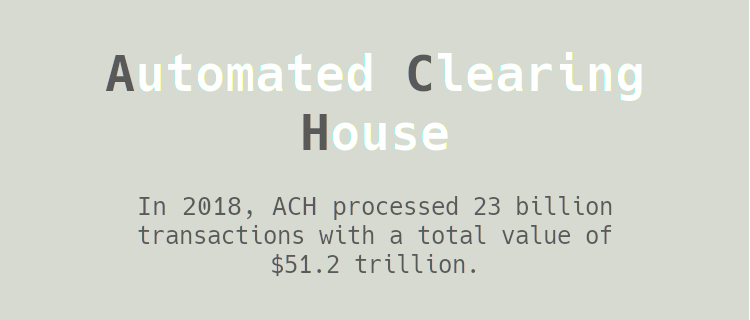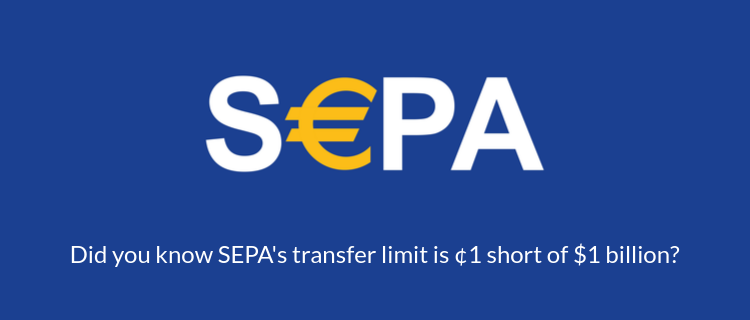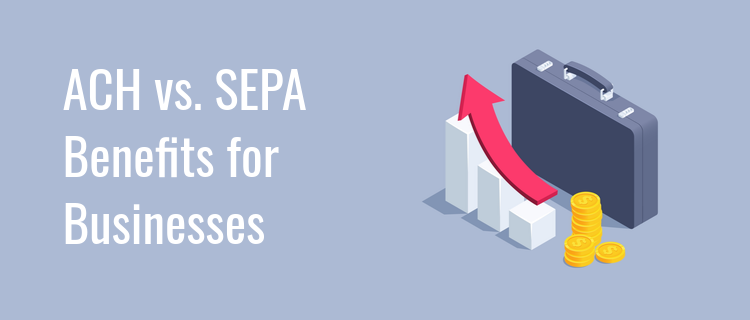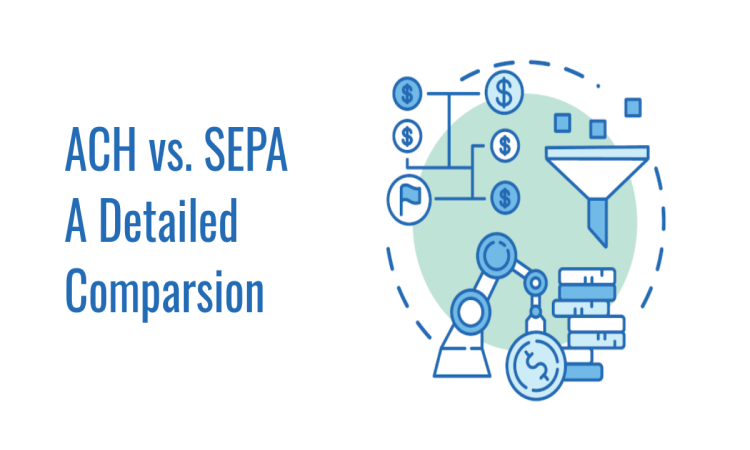ACH and SEPA are two payment frameworks that play a prominent role in banking and finance. ACH is region-specific to the US, whereas SEPA is available within the European Economic Area (EEA). Understanding how the ACH and SEPA payment networks work is essential for businesses operating in these territories.
ACH and SEPA perform the same functions, so it is possible to make a direct comparison between the two to illustrate their similarities and differences. Here is everything you need to know.
ACH vs. SEPA: Definitions
ACH
ACH stands for Automated Clearing House. The ACH is a computer-based network for processing electronic transactions between different parties, including consumers, merchants, and the government. ACH underpins the National Automated Clearing House Association or Nacha, the institution which oversees the development, management, and governance of electronic payments in the US.
ACH is mainly used for low-value, non-urgent domestic payments between financial institutions. It the following payment types:
- Credit Transfers. Initiated by the payer; includes transactions such as direct deposits, payrolls, retail payments, and vendor payments.
- Direct Debit Transfers. Initiated by the payee with pre-authorization from the payer; includes transactions such utility bills, insurance premiums, mortgage loans, and other types of bills.

SEPA
SEPA stands for Single Euro Payments Area, a payment integration initiative within the European Economic Area. SEPA's goal is to develop a uniform, pan-European payment framework to improve the efficiency of cross-border payments between EU member-states. In terms of functionality, SEPA provides systems for electronic transactions between consumers, businesses, and local, federal, and state governments anywhere in the Eurozone.
SEPA supports:
- Credit Transfers. Initiated by the payer; typically used for one-time transfers between parties.
- Instant Credit Transfers. Same as above, but with a guaranteed maximum processing delay of 10 seconds; available only in select SEPA states.
- Core Direct Debit Transfers. Typically used for recurring payments between businesses and consumers.
- Direct Debit B2B Transfers. Used for B2B transactions; comes with additional security features such as mandates submitted by both parties; non-refundable once debited from the payer.
The European Economic Area (EEA) includes all European Union member states and three non-EU countries: Iceland, Norway, and Lichtenstein. Other countries and territories participating in the SEPA scheme are Andorra, Switzerland, Monaco, San Marino, the United Kingdom, the Vatican, Mayotte, Saint-Pierre de Miquelon, Guernsey, Jersey, and the Isle of Man.

ACH vs. SEPA: How Do They Work?
ACH
ACH transfers involve three parties:
- Originator. A business or individual who initiates the ACH transaction. Their bank starts the ACH payment process.
- Recipient. The organization or individual who receives the transaction.
- NACHA. Supervises the transaction. Once all requirements are met, NACHA approves the transaction.
Here is a basic illustration of an ACH transfer procedure:
- The originator requests a transaction by contacting their bank.
- ACH network validates transaction details and payment data.
- The recipient fulfills the request.
ACH transactions are not processed individually. Instead, they are aggregated into batches, and then processed en masse. This keeps transaction costs down, but extends processing time.
Note: For an in-depth look at how ACH works, check out our guide on ACH payment processing.
SEPA
SEPA transfers follow a similar procedure to ACH but use different terminology to denote the parties involved.
To initiate the transfer, the payee:
- Provides bank account information (IBAN and BIC).
- Specifies the payment amount, taking into account transfer limits.
- Signs a payment authorization agreement (the SDD Mandate).
Upon receiving the transfer request, the payer signs the mandate to complete the transaction.
There are slight variations in how SEPA transfers work depending on transfer type:
- SEPA Credit Transfers. Both the payer and the payee must provide their IBAN code.
- SEPA Instant Credit Transfer. Banks of both parties must be registered SEPA Instant members.
- SEPA Core Direct Debit Transfer. The payer doesn't have to authorize each transfer for recurring payments.
- SEPA Direct Debit B2B Transfer. There are additional validation steps to confirm the transaction.
Note: For a deeper dive into SEPA payments, check out our article What Are SEPA Payments and How Do They Work.
ACH vs. SEPA: Comparison Table
ACH and SEPA are region-specific systems designed with different purposes in mind. That said, they share many of the same features and offer similar services overall.
Here is a comparison table listing their main characteristics:
| Category | ACH | SEPA |
|---|---|---|
| Region | United States | European Economic Area |
| Processing times |
|
|
| Use cases |
|
|
| Transaction limit | $100 000 per day. |
|
| Currency | USD | EUR |
| Processing | One-phase processing | Two-phase processing |
| Same-day Payments | Yes (Same-Day ACH) | Yes (SEPA Instant Payment) |
| Support recurring payments | Yes | Yes |
| Transaction fees | 0.5% - 1.5% | Free or minimal fees. |
ACH vs. SEPA: Benefits for Businesses

The purpose of ACH and SEPA is to create a frictionless payment processing environment for businesses, governments, and consumers. To this end, each of them offers a range of benefits and features.
ACH
ACH offers:
- Low Processing Fees. ACH typically incurs a fee between $0.20 - $1.50 per transaction.
- Recurring Payments Support. ACH payments are well-suited for subscription-based business models. Payments are debited automatically from the customer accounts at scheduled intervals upon authorization.
- Security. ACH transfers are only initiated after strict authorization by both payer and payee. No third parties are involved.
- Reduced Risk of Payment Failure. ACH payments are conducted between financial institutions, so there is less risk of customer chargeback.
SEPA
SEPA offers:
- Cross-border Payments. SEPA facilitates easy cross-border payments between participating countries.
- High Transaction Limit. SEPA credit transfers allow transfers of up to one cent short of $1 billion ($999,999,999). The limit on SEPA Instant Credit Transfers is $100,000. There is no limit on Direct Debits.
- Instant Payments. SEPA supports payments with a 10-second delay with its Instant Credit Transfer feature.
- Collect Variable Amounts. SEPA's Direct Debit feature enables merchants to collect variable amounts using a single up-front authorization. When the payment amount changes, merchants can automatically claim the new amount.
Note: Refer to our article ACH vs. EFT to learn how these two payment processing terms compare.
Conclusion
ACH and SEPA are essential elements of the global financial system. They represent two regional implementations of the same underlying system, and share many of the same advantages. Understanding how ACH and SEPA work is a prerequisite for taking your business to the global market.
